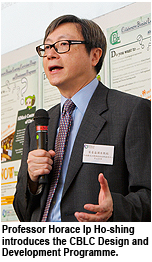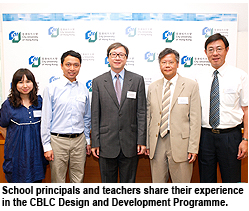CityU offers school teachers free training workshop on using IT in education
City University of Hong Kong (CityU) holds free training workshops to help primary and secondary school teachers fully utilise web-based tools and systems to support teaching. The workshops are part of the Collaborative Blended Learning Curriculum (CBLC) Design and Development Programme, which offers one-stop service of technology support and consultation to assist schools to meet the challenges of information technology (IT) in education.
The use of IT and multimedia resources in education has already become a dominant trend. A teacher nowadays does not simply transfer knowledge, but more importantly works as a facilitator and demonstrator of effective learning through IT. Teaching professionals need to be familiar with and competent in exploiting the advantages of these advanced educational tools. Numerous online learning platforms provide one-way drill-and-practice exercises for students’ self learning. However, without teachers’ involvement in the online learning process and curriculum design, these platforms are unable to fully integrate and support teaching and learning.
To help front-line teaching professionals understand and apply blended learning, CityU launched the CBLC Design and Development Programme with a grant of $2 million from the Quality Education Fund. This school-based programme provides continuing professional training for teachers and offers technology support and consultation services. It aims to equip school teachers with the knowledge and skills they need to make good use of online teaching tools and interactive learning resources, and develop blended learning activities and curriculums that cater for students’ different learning abilities and foster self-directed learning. The first two workshops were held in 2008-09, with the participation of over 150 teachers from more than 50 primary and secondary schools. The third workshop will be arranged this September.
Professor Horace Ip Ho-shing, Chair Professor of the Department of Computer Science and Director of the Centre for Innovative Applications of Internet and Multimedia Technologies (AIMtech Centre), said recent intense debates in the education sector on whether to replace conventional printed textbooks with electronic textbooks (e-books) and whether schools should purchase 7-inch-screen notebook computers addressed relatively minor issues concerning the future development of IT in education in Hong Kong. It has been assumed that adopting e-books can help alleviate the annual increase in the cost of textbooks and reduce the weight of school bags. However, a more important issue to consider concerns the human factor of how effectively we can make use of and integrate IT infrastructure, web-based learning platforms and multimedia content in our pursuit of a quality education and better learning outcomes.
Professor Ip added that competence in IT in education implies an ability to realise the synergies of e-resources, pedagogy and technology. In other words, it is necessary to understand how to blend and exploit the respective advantages of in-class teaching activities and online learning, with the support of new media, advanced educational tools and platforms, and complementary facilities.
“IT technology can be introduced to teaching and learning only when the teachers understand and implement the concepts and methods of blended learning and have full support of a web-based learning platform. Their workload will be reduced rather than increased. Scheduled class hours can be better used to satisfy students’ different learning needs and students can extend their learning beyond the class hours,” said Professor Ip.
Widely adopted in western countries with positive effects, blended learning mixes conventional face-to-face teaching with e-learning to encourage students’ self-directed learning through teachers’ demonstration. Mr Julian Yip Kai-kwan, Principal of St Andrew’s Catholic Primary School, said blended learning is the new education trend in Hong Kong and he has decided to adopt a blended learning curriculum for Primary 1 students starting from the 2009-10 academic year.
The CBLC Design and Development Programme makes use of the Collaborative Blended Learning (CBL) System, a web-based learning platform which originated in the Web-based Learning System (WELS) developed at CityU five years ago. Equipped with rich teaching, communication and monitoring tools, the CBL System not only reduces teachers’ workload but also provides a framework for schools to develop school-based IT-enriched curriculums with its diverse blended learning curriculum templates. The system also encourages collaboration between schools and parents, enhances students’ learning interest, enriches their learning experience, and fosters parent-child relationships.
Mr Ip Sing-piu, Principal of Shak Chung Shan Memorial Catholic Primary School, said blended learning enables students’ learning progress to be monitored systematically, helping teachers to easily tackle the problem of learning differences by checking students’ learning needs and progress. Mr Ip said he would use blended learning as the framework to implement his IT in education strategic plan and to develop his school-based curriculum. Blended learning also served as a framework for deep integration of IT in formal classroom teaching and out-of-class self learning.
Mr Nicky Lee Hin-lun, an English subject teacher at St Patrick’s Catholic Primary School (Po Kong Village Road), observed that a CBL-designed curriculum has significantly improved students’ English proficiency. “The English reading course designed by the CBL System has effectively enhanced students’ reading skills. The design of chapter reading not only made my teaching in the classroom more interactive and smooth but also heightened students’ learning interest.” he said.
The CBL System will be upgraded each year according to the needs of teachers and students. In the coming school year, the system will add new features, such as pictorial story writing and creative writing, English phonetic and poetic writing, to inspire students’ creativity and increase their learning interest. Some challenging educational games will also be added to increase students’ enjoyment while learning. The system has already enhanced its functions to record and monitor students’ learning progress in order to help teachers better understand and deal with students’ learning differences and to help students, their parents and teachers to better understand their learning interests, needs and progress.

